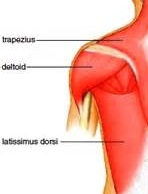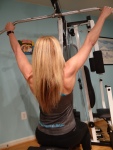Welcome to my primer on working your back. Everyone needs a strong back to protect the spine, and to balance all that work you’ve been doing to build your chest!
I have provided a plan and some variations for chest exercises in an earlier blog post.Weak upper body? Train chest! As I mentioned in the post for triceps, you should also work biceps for balance and strength. If you only work one side of a muscle pair, then you will create some issues of their own, and at a minimum the first issue will be a lack of overall strength. Therefore since we have muscle exercises for our chest, we also need muscle exercises for the back!
The number one exercise for your back is posture. Yes, posture. Shoulders back, chest up sitting or standing erect, and no slouching. If your posture has gotten lazy, this will be tiresome to maintain. However, before you jump into exercise and risk hurting your back, focus on your posture. Sit or stand with your head and back aligned and time it. Keep increasing time until you can maintain this without tiring.
As chest exercises are push exercises the opposite for back are pull exercises. Not pushups, but pullups! Yikes. For many women especially, if you have not been training, guess what? You do not have the strength to pull your body up! This is not just arm strength, but back strength! To build that strength, pull a weighted bar down! Keep increasing weight until you can pull nearer to your weight! Tip: losing a few pounds will help too!
For my little home gym, a back workout would consist of the following exercises.
Back Exercise 1. Wide Grip Pull downs. Lats. (Latissimus Dorsi)
- 1. Wide Grip
- 2. Start extended, chest up.
- 3. Pull the bar to your chest.
- 4. Retract Shoulder Blades
Exercise 2. Close Grip Pull downs. Lats.
This exercise is a reverse grip with your palms facing toward you on the bar. The hands should be less than shoulder width apart. Pull the bar to the chest, keep head up and aligned with back. Release tension slow and controlled. Count of two-three seconds. All exercises need 8 to 12 reps and those reps repeated 4 times with short rests between.Exercise 3. Barbell Row. Middle Back.
This exercise is done by bending at a 45° angle, with knees slightly bent. Start with the bar hanging and pull to your lower abdomen. Keep back, neck, and head aligned and focus! In addition to good form on these exercises with your spine, be aware of good form on your wrists. Do not torque up the wrist on the pull. Keep the back of your hand from your knuckles to your elbow relatively flat. Exercise 4. Dumbbell row. Middle back. This is a single arm row, alternate after each set of 8-12 to the other side. Quick breather between sides. One knee on a flat bench or row bench. Hand secure. Standing leg a bit away from the bench to make a stable base. Square the shoulders, keep that back posture set with your head neutral or up just slightly. No looking at your chest with heavy weight in your hands! Bring the weight to hang down and then perform the lift by pulling the weight toward your hip with elbow bending and moving up. Pull from the back. This is not an arm exersize! Return slowly back to start. Same volume.Exercise 5. Straight arm Pull down. Lats.
The straight arm pulldown is done by grasping a bar on a cable attachment at shoulder width with straight arms. You will stand straight, with a very slight bend in your hips to achieve full range of motion on the bar at the lowest point with your arms perpendicular to the ground. You back should either be straight or arched up slightly. Never round the back. Again, strong pull down, slow return up against the weight. Challenging weight for approximately 40 reps divided into 3 or 4 sets with rests between sets.Exercise 6.Rear delt row.
Rear delts! The deltoid is the shoulder muscle. On your back, that muscle is connected to the shoulder blade. To work all of your strength in the back, pull exercises that focus on the upper back where the shoulder makes that connection are called rear delt exercises. Some programs place these exercises on shoulder day workouts not back. It does not matter if you treat them as a shoulder muscle and work them on your shoulder day or work them with back; only that you do not leave them out of your plan.
blade. To work all of your strength in the back, pull exercises that focus on the upper back where the shoulder makes that connection are called rear delt exercises. Some programs place these exercises on shoulder day workouts not back. It does not matter if you treat them as a shoulder muscle and work them on your shoulder day or work them with back; only that you do not leave them out of your plan.
The exercise above is similar to the barbell row. The difference between this and exercise 3. First, start with your grip a little wider. Your bend should be deeper, almost with your back parallel to the floor. Your row is straight up with your elbows to the sides rather than pulling back beyond your waist.
Side note: you can use a straight bar on all of these row exercises, my curl bar is what I have, so I use it, but my grip is wider than the angled part of the bar anyway.
Exercise 7. Rear Delt flyes (Seated, standing or lying facing incline or with cables)
These are shown standing. Like many exercises, there are variations. This can be done with various gym equipment like a butterfly or cable. It can be performed with dumbbells by lying face down on an incline bench, seated bent over, or standing. This standing position is similar to the row position, with back straight, knees slightly bent, and hips bent so that your back is nearly parallel with the floor. Start with arms down, dumbbells in hand with elbows slightly bent. The elbow bend length should stay the same. If you bend your elbows more when you lift here, it becomes more of a row. The trick here is to not swing too much. Lift controlled and control the weight back to start.Most of my days consist of on or pairs of body parts, with 5 to 10 exercises depending on time size of muscle worked, number of sets per muscle group, type of lifts selected, and goal for the day. These exercises as shown is my ideal basement workout for my back. It mixes up the individual parts of the back worked and hits the targeted muscle from more than one exercise.
Check out my other blog entries for more lifting and nutrition tips, and contact me if you want a workout plan that fits your home gym or a plan to take to your gym location.
Work the Pieces of a Fit Life!
Samantha





















